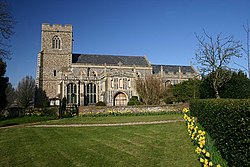Glemsford
| Glemsford | |
| Suffolk | |
|---|---|
 Parish Church of St Mary | |
| Location | |
| Grid reference: | TL833482 |
| Location: | 52°6’0"N, 0°40’8"E |
| Data | |
| Population: | 3,382 (2011[1]) |
| Post town: | Sudbury |
| Postcode: | CO10 |
| Dialling code: | 01787 |
| Local Government | |
| Council: | Babergh |
| Parliamentary constituency: |
South Suffolk |
Glemsford is a village and parish in the Babergh hundred of Suffolk, near the town of Sudbury. Glemsford is located near the River Glem and the River Stour also flows nearby. Glemsford is surrounded by arable farmland and is not far from historic Suffolk villages such as Lavenham and Long Melford.
History

The village is first recorded before the Norman conquest in the S1051 charter of Edward the Confessor granting lands to Ely Abbey. The Domesday Book records the population of Glemsford in 1086 to be 40 households made up of 16 villagers, 1 freeman, 18 smallholders, and 5 slaves along with 8 cattle, 32 pigs, 200 sheep, 3 other animals, 12 acres of meadow, 5 woodland pigs, a mill and a church.[2]
The village has noteworthy features such as Monks Hall, which is a medieval timber structure. It is said that a tunnel once connected Monks Hall to the nearby Parish Church of St Mary the Virgin, which the monks formerly used to access the church instead of mixing with the ordinary villagers. Only a small part of this tunnel remains. The Parish Church of St Mary the Virgin dates back to the early 14th century, with the earliest recorded rector being Hugh de Poynton in 1302. The church features the Golding Chapel, built in memory of the rich Glemsford cloth merchant, John Golding. Golding lived in the Angel House, another timber building adjacent to The Angel public house, which serves traditional real ales. Golding left money for the chapel to be built when he died, likewise as with other parish churches St Mary's Church tower was rebuilt in the 19th century. Monks Hall itself has gone through changes of use and appearance through the centuries and is now a private residence. Glemsford Methodist Church is situated at the other end of the village and dates from the Victorian era.
In the early 16th century, Glemsford became the home of George Cavendish who was a local nobleman and gentleman-usher to Cardinal Thomas Wolsey. Upon Wolsey's death in 1530, Cavendish retired to Glemsford and in the mid-1550s he finalised a biography on Cardinal Wolsey which was published after his own death in 1562.
The village and the surrounding area, like much of East Anglia, was strongly Puritan during much of the 17th century. By 1640, several families had departed for the Massachusetts Bay Colony as part of the wave of emigration that occurred during the Great Migration.[3]
Glemsford railway station was on the route between Sudbury and Cambridge, known as the Stour Valley Railway. The station opened in the 1860s and saw its busiest period during the First and Second World Wars when it, along with nearby Cavendish station, was bombed. This was because Glemsford station was one of the places which harboured ammunition trains. The station was closed during in 1967; only the Station House (now private), goods shed (now converted to flats) and one level crossing post remain.

Glemsford is a large village by Suffolk standards; it also has a considerable number of shops and public houses. Among the public houses are, The Angel, and The Cherry Tree.
Notable residents
- George Cavendish (1497–1562), writer, best known as the biographer of Cardinal Thomas Wolsey.
- Edmund Boldero (1608–1679), royalist clergyman and academic, Master of Jesus College, Cambridge from 1663.
- William Falkner (d. 1682), Anglican divine and learned champion of the Church of England.
- Charles Morgan (1678–1736), clergyman and Master of Clare College from 1726 until his death.
- Frederick Cradock (1886–1943), boilerman posthumously awarded the George Cross for heroism in his attempts to save a workmate from boiling steam from an accident in the parish.
- Jonathan Green, author and investigative journalist specialising in narrative non-fiction.
Outside links
| ("Wikimedia Commons" has material about Glemsford) |
- Glemsford Parish Council website
- www.glemsford.org.uk
- A Short History of Glemsford Rev Kenneth W. Glass, former Rector of St. Mary the Virgin, Glemsford.
References
- ↑ "Parish population 2011". http://www.neighbourhood.statistics.gov.uk/dissemination/LeadKeyFigures.do?a=7&b=11123753&c=Glemsford&d=16&e=62&g=6465534&i=1001x1003x1032x1004&m=0&r=1&s=1442054355686&enc=1.
- ↑ "Glemsford | Domesday Book". https://opendomesday.org/place/TL8348/glemsford/.
- ↑ Thompson, Roger, Mobility & Migration, East Anglian Founders of New England, 1629-1640, Amherst: University of Massachusetts Press, 1994.
- Mee, Arthur, Ed., The King's England, Suffolk, our Farthest East, London: Hodder & Stoughton, 1947 (reprint), 171–72.